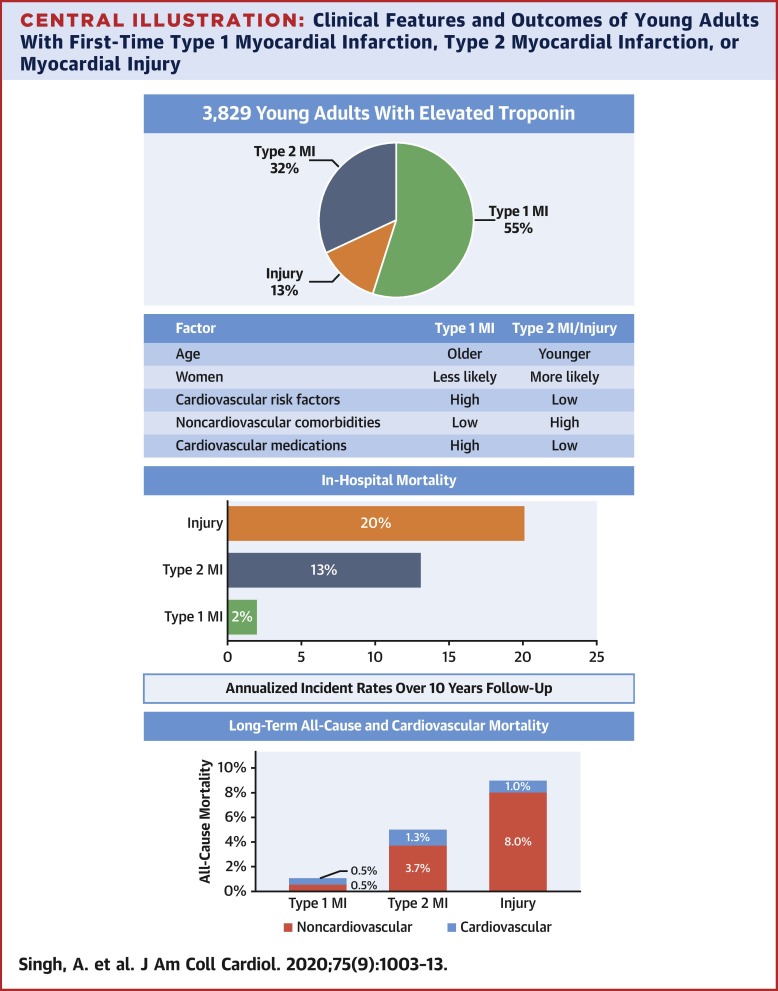当前位置:
X-MOL 学术
›
J. Am. Coll. Cardiol.
›
论文详情
Our official English website, www.x-mol.net, welcomes your
feedback! (Note: you will need to create a separate account there.)
Cardiovascular Mortality After Type 1 and Type 2 Myocardial Infarction in Young Adults
Journal of the American College of Cardiology ( IF 21.7 ) Pub Date : 2020-03-01 , DOI: 10.1016/j.jacc.2019.12.052 Avinainder Singh 1 , Ankur Gupta 2 , Ersilia M DeFilippis 3 , Arman Qamar 2 , David W Biery 2 , Zaid Almarzooq 2 , Bradley Collins 2 , Amber Fatima 4 , Candace Jackson 5 , Patrycja Galazka 2 , Mattheus Ramsis 2 , Daniel C Pipilas 2 , Sanjay Divakaran 2 , Mary Cawley 2 , Jon Hainer 2 , Josh Klein 2 , Petr Jarolim 6 , Khurram Nasir 1 , James L Januzzi 7 , Marcelo F Di Carli 2 , Deepak L Bhatt 2 , Ron Blankstein 2
Journal of the American College of Cardiology ( IF 21.7 ) Pub Date : 2020-03-01 , DOI: 10.1016/j.jacc.2019.12.052 Avinainder Singh 1 , Ankur Gupta 2 , Ersilia M DeFilippis 3 , Arman Qamar 2 , David W Biery 2 , Zaid Almarzooq 2 , Bradley Collins 2 , Amber Fatima 4 , Candace Jackson 5 , Patrycja Galazka 2 , Mattheus Ramsis 2 , Daniel C Pipilas 2 , Sanjay Divakaran 2 , Mary Cawley 2 , Jon Hainer 2 , Josh Klein 2 , Petr Jarolim 6 , Khurram Nasir 1 , James L Januzzi 7 , Marcelo F Di Carli 2 , Deepak L Bhatt 2 , Ron Blankstein 2
Affiliation

|
BACKGROUND
Type 2 myocardial infarction (MI) and myocardial injury are associated with increased short-term mortality. However, data regarding long-term mortality are lacking. OBJECTIVES
This study compared long-term mortality among young adults with type 1 MI, type 2 MI, or myocardial injury. METHODS
Adults age 50 years or younger who presented with troponin >99th percentile or the International Classification of Diseases code for MI over a 17-year period were identified. All cases were adjudicated as type 1 MI, type 2 MI, or myocardial injury based on the Fourth Universal Definition of MI. Cox proportional hazards models were constructed for survival free from all-cause and cardiovascular death. RESULTS
The cohort consisted of 3,829 patients (median age 44 years; 30% women); 55% had type 1 MI, 32% had type 2 MI, and 13% had myocardial injury. Over a median follow-up of 10.2 years, mortality was highest for myocardial injury (45.6%), followed by type 2 MI (34.2%) and type 1 MI (12%) (p < 0.001). In an adjusted model, type 2 MI was associated with higher all-cause (hazard ratio: 1.8; 95% confidence interval: 1.2 to 2.7; p = 0.004) and cardiovascular mortality (hazard ratio: 2.7; 95% confidence interval: 1.4 to 5.1; p = 0.003) compared with type 1 MI. Those with type 2 MI or myocardial injury were younger and had fewer cardiovascular risk factors but had more noncardiovascular comorbidities. They were significantly less likely to be prescribed cardiovascular medications at discharge. CONCLUSIONS
Young patients who experience a type 2 MI have higher long-term all-cause and cardiovascular mortality than those who experience type 1 MI, with nearly one-half of patients with myocardial injury and more than one-third of patients with type 2 MI dying within 10 years. These findings emphasize the need to provide more aggressive secondary prevention for patients who experience type 2 MI and myocardial injury.
中文翻译:

年轻人 1 型和 2 型心肌梗死后的心血管死亡率
背景 2 型心肌梗塞 (MI) 和心肌损伤与短期死亡率增加有关。然而,缺乏关于长期死亡率的数据。目的 本研究比较了患有 1 型 MI、2 型 MI 或心肌损伤的年轻成人的长期死亡率。方法 确定了 50 岁或以下的成年人,这些成年人在 17 年期间出现肌钙蛋白 >99% 或 MI 的国际疾病分类代码。所有病例均被判定为 1 型 MI、2 型 MI 或基于 MI 的第四通用定义的心肌损伤。构建 Cox 比例风险模型以确保无全因死亡和心血管死亡的生存。结果 该队列包括 3,829 名患者(中位年龄 44 岁;30% 为女性);55% 有 1 型 MI,32% 有 2 型 MI,13% 有心肌损伤。在中位随访 10.2 年中,心肌损伤的死亡率最高 (45.6%),其次是 2 型 MI (34.2%) 和 1 型 MI (12%) (p < 0.001)。在调整后的模型中,2 型 MI 与更高的全因(风险比:1.8;95% 置信区间:1.2 至 2.7;p = 0.004)和心血管死亡率(风险比:2.7;95% 置信区间:1.4 至5.1;p = 0.003)与 1 型 MI 相比。2 型 MI 或心肌损伤患者更年轻,心血管危险因素更少,但非心血管合并症更多。他们出院时服用心血管药物的可能性要小得多。结论 经历 2 型 MI 的年轻患者的长期全因死亡率和心血管死亡率高于经历 1 型 MI 的患者,近二分之一的心肌损伤患者和超过三分之一的 2 型心梗患者在 10 年内死亡。这些发现强调需要为经历 2 型 MI 和心肌损伤的患者提供更积极的二级预防。
更新日期:2020-03-01
中文翻译:

年轻人 1 型和 2 型心肌梗死后的心血管死亡率
背景 2 型心肌梗塞 (MI) 和心肌损伤与短期死亡率增加有关。然而,缺乏关于长期死亡率的数据。目的 本研究比较了患有 1 型 MI、2 型 MI 或心肌损伤的年轻成人的长期死亡率。方法 确定了 50 岁或以下的成年人,这些成年人在 17 年期间出现肌钙蛋白 >99% 或 MI 的国际疾病分类代码。所有病例均被判定为 1 型 MI、2 型 MI 或基于 MI 的第四通用定义的心肌损伤。构建 Cox 比例风险模型以确保无全因死亡和心血管死亡的生存。结果 该队列包括 3,829 名患者(中位年龄 44 岁;30% 为女性);55% 有 1 型 MI,32% 有 2 型 MI,13% 有心肌损伤。在中位随访 10.2 年中,心肌损伤的死亡率最高 (45.6%),其次是 2 型 MI (34.2%) 和 1 型 MI (12%) (p < 0.001)。在调整后的模型中,2 型 MI 与更高的全因(风险比:1.8;95% 置信区间:1.2 至 2.7;p = 0.004)和心血管死亡率(风险比:2.7;95% 置信区间:1.4 至5.1;p = 0.003)与 1 型 MI 相比。2 型 MI 或心肌损伤患者更年轻,心血管危险因素更少,但非心血管合并症更多。他们出院时服用心血管药物的可能性要小得多。结论 经历 2 型 MI 的年轻患者的长期全因死亡率和心血管死亡率高于经历 1 型 MI 的患者,近二分之一的心肌损伤患者和超过三分之一的 2 型心梗患者在 10 年内死亡。这些发现强调需要为经历 2 型 MI 和心肌损伤的患者提供更积极的二级预防。











































 京公网安备 11010802027423号
京公网安备 11010802027423号